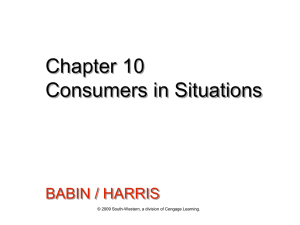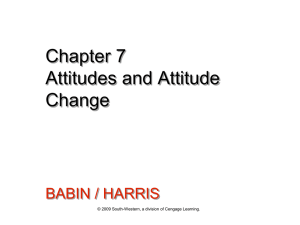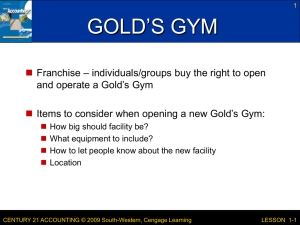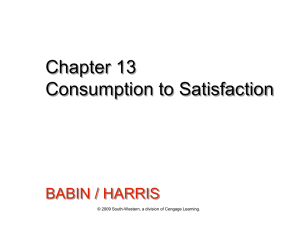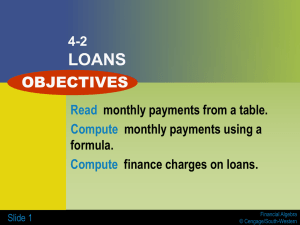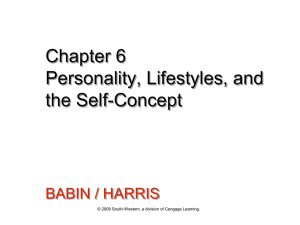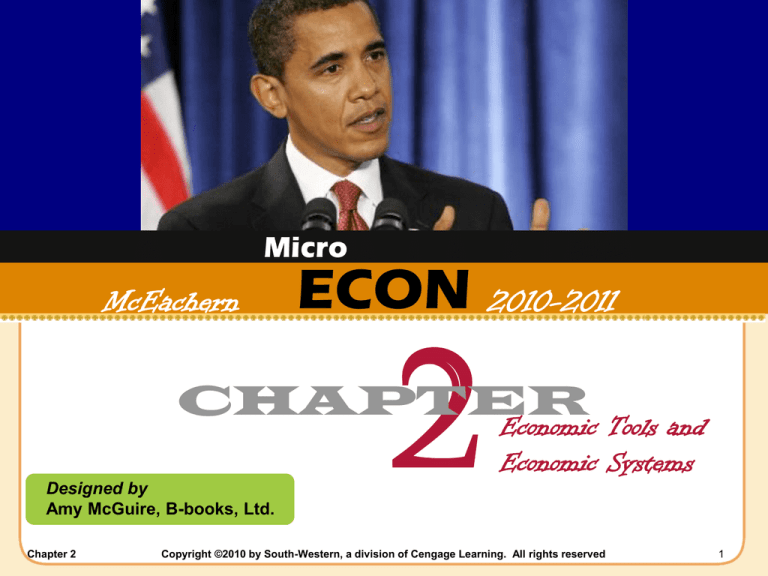
Micro
McEachern
ECON 2010-2011
2
CHAPTER
Economic Tools and
Economic Systems
Designed by
Amy McGuire, B-books, Ltd.
Chapter 2
Copyright ©2010 by South-Western, a division of Cengage Learning. All rights reserved
1
Choice and Opportunity Cost
Scarcity
Make a choice
LO1
Chapter 2
Pass up another
opportunity
Opportunity cost
The value of the best
alternative forgone
Opportunity lost
Monetary aspect
Non-monetary aspect
Copyright ©2010 by South-Western, a division of Cengage Learning. All rights reserved
2
Case Study
LO1 The Opportunity Cost of College
Chapter 2
Value of best alternative forgone
Forgone income
(full-time job; $20,000)
Minus income earned as a student
(part-time work: $10,000)
Plus direct cost of college
Tuition, fees, books ($6,000)
$20,000 - $10,000 + $6,000 = $16,000
Not included: room, board,
personal expenses
Copyright ©2010 by South-Western, a division of Cengage Learning. All rights reserved
3
Opportunity Cost
Opportunity cost is subjective
‘the road not taken’
Calculating opportunity cost
Requires time and information
Time: the ultimate constraint
Opportunity cost varies with
circumstance
Depends on the alternative
LO1
Chapter 2
Copyright ©2010 by South-Western, a division of Cengage Learning. All rights reserved
4
Sunk Cost and Choice
Sunk cost
Incurred cost
Cannot be recovered
Ignored when making
economic choices
Economic decision makers
Relevant: costs affected by
the choice
Irrelevant: sunk costs
LO1
Chapter 2
Copyright ©2010 by South-Western, a division of Cengage Learning. All rights reserved
5
Law of Comparative
Advantage
Specialize in the task that you do better
Law of comparative advantage
Specialize in producing a good IF
Lower opportunity cost of
producing it
Specialization and exchange
Better off
Absolute advantage
Use fewer resources
LO2
Chapter 2
Copyright ©2010 by South-Western, a division of Cengage Learning. All rights reserved
6
Specialization and
Exchange
Barter
Trade products for other products
Simple economies
Few goods
Little specialization
Money
Medium of exchange
Facilitates exchange
Greater specialization
LO2
Chapter 2
Copyright ©2010 by South-Western, a division of Cengage Learning. All rights reserved
7
Division of Labor
Division of labor
Specialization; Increased
productivity
Individual preferences; natural
ability
Experience
No need to shift between tasks
Laborsaving machinery
Downside:
Repetitive, tedious
Routine tasks - robots
LO2
Chapter 2
Copyright ©2010 by South-Western, a division of Cengage Learning. All rights reserved
8
Efficiency and the PPF
Production Possibilities Frontier (PPF)
Assumptions
Output: consumer and capital goods
Productions: 1 year
Fixed resources (quantity, quality)
Fixed technology
Fixed ‘rules of the game’
Resources – scarce for the economy
Economy’s production options
LO3
Chapter 2
Copyright ©2010 by South-Western, a division of Cengage Learning. All rights reserved
9
Efficiency and the PPF
PPF
Possible combinations of
Consumer and Capital goods that
Can be produced using
All resources efficiently
Inefficient combinations
Unattainable combinations
LO3
Chapter 2
Copyright ©2010 by South-Western, a division of Cengage Learning. All rights reserved
10
Consumer goods (millions of units per year)
LO3
Exhibit 1
A
50
48
B
C
43
U
D
34
30
Unattainable
Inefficient
I
20
The Economy’s
Production
Possibilities
Frontier
PPF (AF): Economy uses all
resources and technology
efficiently
E
PPF: bowed out; law of
increasing opportunity cost
10
F
0
10
20
30
40
50
Inefficient: inside PPF
Unattainable: outside PPF
Capital goods (millions of units per year)
Chapter 2
Copyright ©2010 by South-Western, a division of Cengage Learning. All rights reserved
11
The Shape of the PPF
Movement down along PPF
Give up some consumer goods to get
more capital goods
Bowed-out shape
Law of increasing opportunity costs
Slope of PPF
Opportunity cost of 1 unit capital good
LO3
Chapter 2
Copyright ©2010 by South-Western, a division of Cengage Learning. All rights reserved
12
What Can Shift the PPF?
Economic growth
Expansion in the economy’s PPF
1. Changes in resource availability
Outward shift of PPF – increase in:
Size, health of labor force
Skills of labor force
Availability of other resources
2. Increases in capital stock
More output; outward shift of PPF
LO3
Chapter 2
Copyright ©2010 by South-Western, a division of Cengage Learning. All rights reserved
13
What Can Shift the PPF?
3. Technological change
Employs resources more efficiently
Outward shift of PPF
4. Improvements in the rules of the game
Formal and informal institutions
Economic growth
Outward shift of PPF
LO3
Chapter 2
Copyright ©2010 by South-Western, a division of Cengage Learning. All rights reserved
14
LO3
Exhibit 2(a), (b)
Shifts of the Economy’s Production Possibilities Frontier
(b) Decrease in available resources
Consumer goods
Consumer goods
(a) Increase in available resources
A’
A
F
F’
Capital goods
A
A’
F’ F
Capital goods
(a) Outward shift of PPF – increase in available (b) Inward shift of PPF – decrease in
resources; better technology
available resources
- enhanced production of both capital and
- decreased production of both capital
consumer goods
and consumer goods
Chapter 2
Copyright ©2010 by South-Western, a division of Cengage Learning. All rights reserved
15
LO3
Exhibit 2(c), (d)
Shifts of the Economy’s Production Possibilities Frontier
A’
A
F
Capital goods
Chapter 2
(d) Change in resources, technology,
or rules that benefits capital goods
Consumer goods
Consumer goods
(c) Change in resources, technology, or
rules that benefits consumer goods
A
F’
Capital goods
F
Copyright ©2010 by South-Western, a division of Cengage Learning. All rights reserved
16
Case Study
LO3 Rules of the Game and Economic Development
Chapter 2
“Ease of doing business”
Friendly business climate
High standard of living
Sophisticated economy
Difficult business climate
Low standard of living
Poor economy
Copyright ©2010 by South-Western, a division of Cengage Learning. All rights reserved
17
LO3
Exhibit 3
Best 10 and Worst 10 Among 181 Countries Based on
Ease of Doing Business, According to the World Bank
Best 10
Worst 10
1.
2.
3.
4.
5.
6.
172. Niger
173. Eritrea
174. Venezuela
175. Chad
176. São Tomé and Principe
177. Burundi
178. Republic of Congo
179. Guinea-Bissau
180. Central African Republic
181. Democratic Republic of
Congo
Singapore
New Zealand
United States
Hong Kong
Denmark
United
Kingdom
7. Ireland
8. Canada
9. Australia
10.Norway
Chapter 2
Copyright ©2010 by South-Western, a division of Cengage Learning. All rights reserved
18
Case Study
LO3 Rules of the Game and Economic Development
Chapter 2
Sell an imported product
Denmark
3 documents
1 official signature
5 days
Burundi
19 documents
55 official signatures
24 days
Copyright ©2010 by South-Western, a division of Cengage Learning. All rights reserved
19
Case Study
LO3 Rules of the Game and Economic Development
Chapter 2
Business taxes
Belarus
11 taxes; 122% of profit
113 tax payments to 3
government agencies
1,188 hours tax
preparation
Hong Kong
2 taxes; 14% of profit
1 electronic filing
80 hours tax preparation
Copyright ©2010 by South-Western, a division of Cengage Learning. All rights reserved
20
Case Study
LO3 Rules of the Game and Economic Development
Chapter 2
Effectiveness and reliability
of courts
Collect a $1,000 debt
East Timor
$1,800 court and
attorney fees
69 procedures; wait 3
years
Denmark
Cost $65
15 procedures
6 months
Copyright ©2010 by South-Western, a division of Cengage Learning. All rights reserved
21
Case Study
LO3 Rules of the Game and Economic Development
Chapter 2
Possible explanations for
bad business environment
Bad administrative
systems
Favoritism in
governmental jobs
Corruption
Bribes
Copyright ©2010 by South-Western, a division of Cengage Learning. All rights reserved
22
What We Learn from the PPF?
Efficiency
Scarcity
Opportunity cost
Law of increasing opportunity cost
Economic growth
Choice
Costs
Benefits
LO3
Chapter 2
Copyright ©2010 by South-Western, a division of Cengage Learning. All rights reserved
23
Economic Systems
Three questions
What?
How?
For Whom?
Economic system
Mechanisms
Institutions
Answer the three questions
LO4
Chapter 2
Copyright ©2010 by South-Western, a division of Cengage Learning. All rights reserved
24
Economic Systems
Criteria
Ownership of resources
Allocation of resources
Incentives
Range from
Pure capitalism, to
Pure command system
LO4
Chapter 2
Copyright ©2010 by South-Western, a division of Cengage Learning. All rights reserved
25
Pure Capitalism
Private property rights
Unrestricted markets
Answer the three questions
Resources – most productive use
Goods and services – most
valued
Voluntary buying and selling
Adam Smith: “invisible hand”
LO4
Chapter 2
Copyright ©2010 by South-Western, a division of Cengage Learning. All rights reserved
26
Pure Capitalism: Flaws
No central authority
People with no resources could starve
Monopoly
Side effects for people not involved
No public goods
LO4
Chapter 2
Copyright ©2010 by South-Western, a division of Cengage Learning. All rights reserved
27
Pure Command System
Public/communal ownership of
property
Government planners
Central plans
Direct resources
Coordinate production
Answer the three questions
Communism
LO4
Chapter 2
Copyright ©2010 by South-Western, a division of Cengage Learning. All rights reserved
28
Pure Command System:
Flaws
Resources
Used inefficiently
Wasted (no incentives)
Preferences of planners
Limited variety of products
Less freedom of economic choice
LO4
Chapter 2
Copyright ©2010 by South-Western, a division of Cengage Learning. All rights reserved
29
Mixed and Transitional
Economies
Increasing role of
government
In capitalist economies
Increasing role of markets
In command economies
Mixed economies
Government
Economic activity
Regulates the private
sector
Economies based on
custom or religion
LO4
Chapter 2
Copyright ©2010 by South-Western, a division of Cengage Learning. All rights reserved
30


